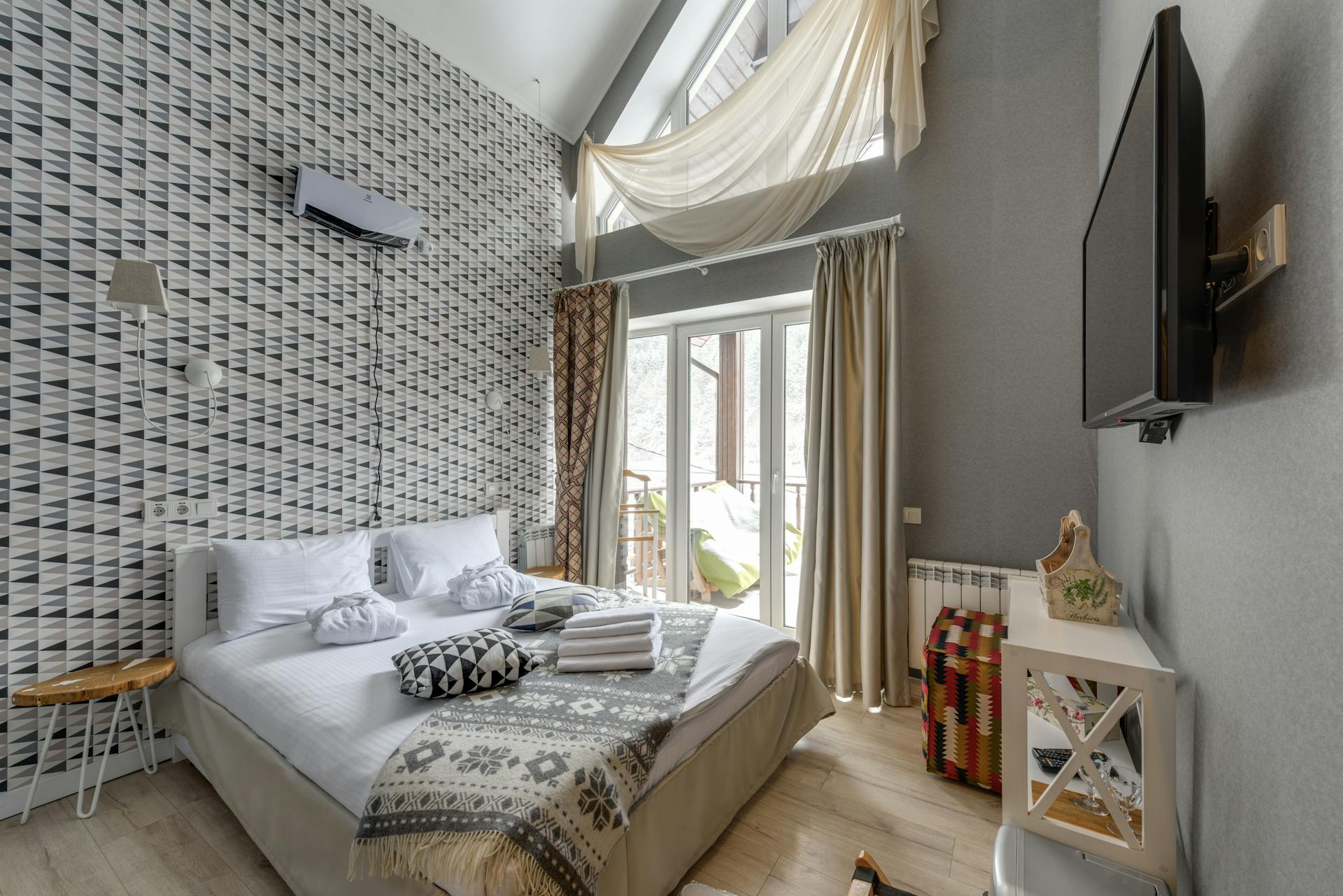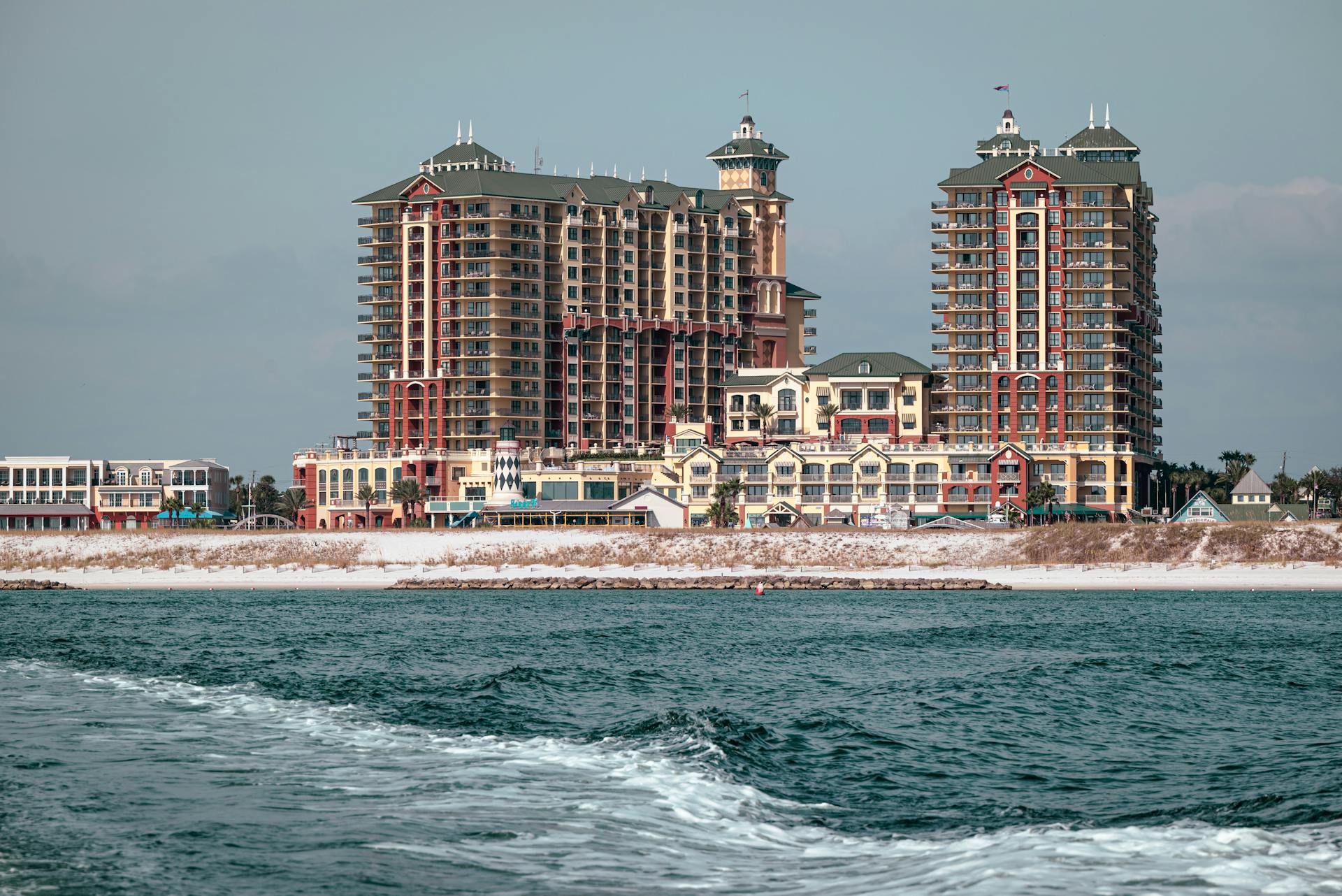
When buying condo insurance, it's essential to consider the condo association's master policy. This policy typically covers the common areas, such as the lobby, hallways, and amenities like a pool or gym.
The condo association's master policy usually doesn't cover your personal belongings, so you'll need to purchase a separate policy for your individual unit. This is often referred to as an "HO-6" policy.
The HO-6 policy covers the interior of your unit, including walls, floors, and ceilings, as well as your personal belongings. It's usually more comprehensive than the condo association's master policy.
If this caught your attention, see: Master Condo Insurance Massachusetts
Condo Insurance Requirements
Condo insurance is typically required by mortgage lenders, so it's essential to have this coverage in place to protect their financial interest during the length of your loan.
Many associations require owners to buy individual condo policies, and they may specify minimum levels of coverage.
If you've paid off your mortgage, you might still be required to maintain condo insurance by your association.
Additional reading: Condo Insurance Coverages
Lenders generally require condo owners with a mortgage to purchase HO-6 insurance, which is a type of condo insurance.
You might have the option to skip condo insurance once you pay off your mortgage, but some associations require owners to maintain a minimum level of coverage.
Condo insurance is not legally required, but it's a good idea to have it to protect yourself from potential losses and damages.
You might enjoy: Condo Insurance Requirements for Mortgage
Condo Insurance Coverage
Your condo association's master insurance policy typically covers damage to the building's exterior, such as storm damage to the roof or siding. This is usually paid for through your condo fees.
The master policy also covers damage to common areas, like the lobby, elevators, hallways, and tennis courts. Injuries sustained in common areas, like a visitor slipping on an icy walkway, are also covered.
The deductible on the master policy is an important consideration. Find out how high the deductible is and how the association would pay it in the event of a claim. This can help you choose the right condo insurance for your individual needs.
Check this out: Does Condo Insurance Cover Water Damage to Other Units
Here's a quick summary of what's covered by the master policy:
- Damage to the building's exterior
- Damage to common areas
- Injuries sustained in common areas
Keep in mind that the master policy might not cover everything, so you'll still need to consider individual condo insurance to protect your personal belongings and dwelling.
Personal Property
Condo insurance covers theft, but you'll need to check your policy for any exclusions. For instance, high-value items like expensive jewelry or rare art pieces may not be covered if you don't have a specific endorsement.
Personal property coverage pays to replace furniture and other belongings if they're stolen or damaged by an event listed in your HO-6 policy, minus your deductible. These "named perils" typically include scenarios like fire, wind, and hail.
A standard condo policy often covers valuables like jewelry, electronics, or artwork only up to certain limits. If you have expensive items, you may need to buy extra coverage.
You'll need to keep track of your personal property, including what's in each cabinet, to ensure you have adequate limits of coverage. One way to do this is to take a home inventory by walking from room to room and making a list of all items.
You might like: Do I Need Condo Insurance
Condo insurance will reimburse you for losses, minus your deductible, if you're a victim of theft. This includes items like a TV, two laptops, and a necklace.
It's essential to obtain adequate limits of coverage for your personal contents and belongings, as this will always be your responsibility as the individual unit owner.
Liability and Medical Payments
Liability and Medical Payments are crucial parts of an individual condo insurance policy. They can help with expenses if someone is hurt in your unit or you accidentally damage someone else's property.
Personal liability coverage kicks in for pricey scenarios such as a lawsuit after your dog bites someone at the park. For this coverage to apply, you must be found responsible for the injury or property damage.
Medical payments coverage generally has a lower limit and can pay the medical bills of someone hurt in your unit, regardless of whether you're at fault. This can be a lifesaver in unexpected situations, like when a friend trips over an extension cord and breaks his wrist while visiting your condo.
Here are some key points to remember about Liability and Medical Payments:
- Personal liability coverage applies when you're found responsible for an injury or property damage.
- Medical payments coverage can pay medical bills regardless of fault, with a generally lower limit.
Scenarios and Exclusions
A typical individual condo insurance policy covers common problems like fire and smoke, explosions, wind and hail, theft, vandalism, lightning, and burst pipes. These are just a few examples of the many scenarios that are covered.
However, there are some scenarios that aren't included. Earthquakes, flooding, intentional injuries to others, nuclear hazards, and damage from birds, rodents, and insects are all excluded. Additionally, damage from wear and tear is also not covered.
Some condo insurance policies are named perils policies, which means they cover damage from specific perils listed in the policy. Here are 16 perils that are typically covered by an HO-6 policy:
- Fire
- Lightning
- Windstorm or hail
- Explosion
- Riot or civil commotion
- Damage caused by aircraft
- Damage caused by vehicles
- Smoke
- Vandalism or malicious mischief
- Theft
- Volcanic eruption
- Falling objects
- Weight of ice, snow, or sleet
- Accidental discharge or overflow of water or steam
- Sudden and accidental tearing apart of a steam or hot water heating system
- Sudden and accidental damage from artificially generated electrical current
Loss Assessment
Loss assessment coverage might help if your condo association goes above the limits of its master policy, such as when repairing major hail damage to the building.
You'll need to check your individual condo policy to see if it covers the cause of the damage in question, like a fire started by your dog that destroys part of the building's roof.
Consider reading: Condo Insurance Cover Water Damage
If your association asks you to contribute to repairs from a cause not covered by your individual policy, like flood damage, loss assessment coverage won't help.
A large deductible in the master policy might be split among all unit owners, or the association could ask an individual unit owner to pay the entire deductible, depending on where the damage originated.
In some cases, loss assessment coverage might not help with special assessments, like a roof replacement due to wear and tear.
Here's an interesting read: In Insurance Policies the Insured Is Not Legally
Scenarios Covered vs. Not Covered
Your typical individual condo insurance policy will cover common problems like fire and smoke, explosions, wind and hail, theft, vandalism, lightning, and burst pipes.
The policy won't cover earthquakes, flooding, intentional injuries to others, nuclear hazards, damage from birds, rodents, and insects, wear and tear, or damage from underground water.
It's worth noting that you may be able to buy extra insurance for some of the scenarios that aren't included.
Here are some specific examples of what your policy might cover and not cover:
Keep in mind that the specifics of your policy will vary, so it's essential to review your policy carefully to understand what's included and what's not.
Vacant or Unoccupied
If you don't live in your condo year-round, you may need vacant home insurance. A standard policy may not cover damage to a condo that's left empty for more than 30 to 60 days.
You should consider vacant home insurance if you're waiting to move into your new condo. This type of insurance is designed to protect your investment while it's unoccupied.
A condo left empty for an extended period can be vulnerable to damage from various sources, including theft, vandalism, and natural disasters.
Readers also liked: With Disability Income Insurance an Insurance Company May Limit
Walls-In
The "Walls-In" scenario is a common one in condo insurance. Under this style of coverage, the Association is responsible for insuring the building and each unit back to the condition of the original construction.
You'll be responsible for any improvements or betterments made to the unit since the original construction. This includes items like new appliances, built-ins, flooring, lighting fixtures, and more.
The unit owner will need to carry adequate limits for these items as well as their personal belongings to be replaced. This is crucial to ensure you're fully covered in case of a loss.
Policy Details and Costs
The average condo insurance cost is $455 per year, according to NerdWallet's rate analysis. This can vary widely depending on where you live, how much coverage you need, and the deductible you choose.
Condo insurance rates can differ significantly from state to state, with Florida having the highest average condo insurance rates at $1,610 a year. This is largely due to the state's vulnerability to extreme weather conditions like hurricanes and strong storms.
Shopping around can help lessen the blow of higher rates in your state. Get quotes for the same level of coverage from at least three home insurance companies and ask about discounts, including bundling discounts.
Here's an interesting read: What to Look for in Cyber Insurance Coverage
Additional Living Expenses
Additional living expenses can be a significant burden if you're forced to leave your home due to a covered event.
If you have a condo insurance policy with loss of use coverage, it can pay for hotel bills and other expenses that go beyond what you'd normally pay while living at home.
For example, if you need to move out of your condo for a couple of weeks during repairs for a burst pipe, your HO-6 policy could cover your hotel bills, restaurant meals, and laundry expenses.
This coverage can help you maintain your standard of living while your home is being repaired or renovated.
Take a look at this: What Is Hazard Insurance on a House
How Much Costs
The cost of condo insurance varies widely depending on several factors. According to NerdWallet's rate analysis, the average condo insurance cost is $455 per year.
The cost of condo insurance can be impacted by location, with some states having significantly higher rates than others. Florida has the highest average condo insurance rates at $1,610 a year, while states like Alaska, Alabama, and Arizona have some of the lowest rates.
Worth a look: Condo Insurance Cost Alameda

The average condo insurance cost nationwide is $795, for $60,000 in personal property coverage, with a $1,000 deductible. However, this cost can vary depending on the specific coverage choices and deductibles chosen.
Here's a breakdown of the average annual premium for condo insurance in each state:
The cost of condo insurance can also be impacted by other factors, including the condition of your unit and your claims history.
All-In
The "All-In" policy is a type of master policy that covers the inside and outside of the building, as well as each unit, back to its pre-loss condition. This includes any additions, alterations, and improvements made by the owner.
With an "All-In" policy, the association is responsible for insuring the entire unit, including any custom features or upgrades. This means that as a unit owner, you only need to insure your personal contents and belongings in the unit.
For example, if you have a custom kitchen or bathroom, the association's master policy would cover the damage to those areas, not just the exterior of the building. This can be a big relief for unit owners who have invested in their space.
Related reading: Condo Master Insurance

Here's a quick rundown of what's typically covered under an "All-In" policy:
- Interior and exterior surfaces of the unit
- Additions, alterations, and improvements made by the owner
- Damage to custom features or upgrades
This type of policy can provide peace of mind for unit owners, knowing that their association has their back in case of an emergency. Just remember to review your master policy to understand exactly what's covered and what's not.
Frequently Asked Questions
What is the 80 20 rule in homeowners insurance?
The 80/20 rule in homeowners insurance recommends insuring your home for at least 80% of its total replacement cost to avoid underinsurance penalties. This ensures you have sufficient coverage in case of a costly loss or damage.
What minimum do most condo owners policies provide?
Most condo insurance policies provide a minimum coverage limit of $100,000. This is the starting point for protecting your condo and assets, but you may want to consider higher limits for added peace of mind.
What is the difference between HO6 and condo insurance?
HO6 insurance covers the interior and personal property of a condo unit, while condo insurance typically only covers the building's common areas, leaving unit owners vulnerable to financial loss
Sources
- https://www.nerdwallet.com/article/insurance/condo-ho6-insurance
- https://www.valuepenguin.com/homeowners-insurance/how-much-dwelling-coverage-to-get-condo-insurance
- https://www.insure.com/home-insurance-faq/ho-6-home-insurance.html
- https://www.robertsonryan.com/charlesdjames/2022/01/04/condos-bare-walls-vs-walls-in-vs-all-in/
- https://clovered.com/how-much-dwelling-coverage-do-i-need-for-a-condo/
Featured Images: pexels.com


